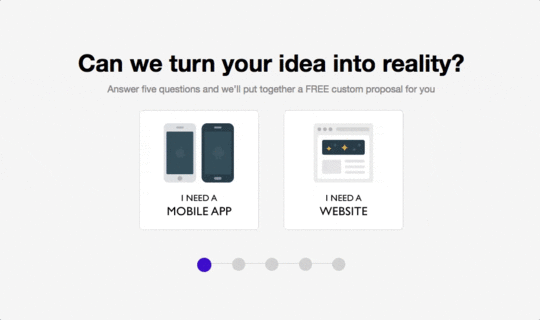9 Best Form Builders for Marketers in 2018
Forms are one of the most important elements of your website and wider marketing strategy. Just about every product purchase, email signup, customer query and every valuable interaction with your target audience takes place over a form of some kind.
Poor form design is going to kill your lead gen strategy and seriously hurt your conversion rates.
Unfortunately, good form design is something of an art while measuring form performance is very much a science. Painstakingly coding and optimising forms, one line at a time, used to be the only option – but today there are plenty of form builder tools promising to help you create high-performance forms almost instantly.
Here’s a look at the best of them in 2018.
#1: JotForm

JotForm is an easy-to-use form builder that helps you create sleek forms for a variety of purposes. This tool has improved a lot over the years and its newer form templates (they’ve got more than 10,000 now) are definitely the best of the bunch.
The platform’s user interface has improved a lot, too, and it won’t be long before you’re putting forms together in minutes, once you get a feel for how things work.
Speed isn’t really the aim with JotForm, though. Almost everything is customisable and to get the best out of this platform you’ll want a solid understanding of form design and the time to customise its themes to suit your needs.
If too much choice is going to slow you down, you might want to look elsewhere.
#2: Leadformly

At the opposite end of the spectrum, you’ve got Leadformly – a form builder that takes out the guesswork and does the thinking for you. Leadformly’s templates have been specifically engineered to generate leads right out of the box with a numer of multistep formats that use conditional logic to adapt questions to the responses of users.
This means you can ask all the questions you need to score your leads effectively without users having to fill out a huge form. They simply never see the questions they don’t need to fill out.
With Leadformly, the focus is on performance and it’s clear the tool doesn’t want you wasting time with customising minor details. You simply build your form, embed it one your page and start converting leads. Once your form is live, Leadformly’s built-in form analytics tool measures your performance and helps you refine your form for better performance over time.
If you want the fastest route to hight-converting web forms, check out Leadformly.
#3: Typeform

Typeform tries to do something a little different with form design. It also takes the multistep and conditional logic approach but creates a more conversational format that works particularly well for quizzes and surveys.
The Typeform concept is to “turn data collection into an experience” and its forms are certainly visually engaging. You’ll need to sign up to the pro version to get the best of its conditional logic, though. More importantly, Typeform doesn’t offer anything in terms of form analytics beyond a very basic “reports” panel. So you’ll need to set up something more sophisticated in Google Analytics or another third-party platform for detailed insights.
#4: Paperform

Paperform is a more traditional form builder but it aims to find that sweet spot between speed and customisability. Its user interface is sleek and Paperform has done a decent job of making extensive opitons easy to navigate. The dowside of extensive options is you have to spend time going through them all – only you can decide if this is a productivity issue for you.
There’s also a Paperform Agency version if you want to use this tool for your customers but it’s disappointing to see no form analytics or optimisation features, once again.
#5: Ninja Forms

Ninja Forms is one of the most popular form builders for WordPress and it packs a lot of options and features into its plugin. Considering its interface is limited to the confines of the WordPress dashboard, the devs behind Ninja Forms have done really well to keep things so intuitive – especially considering the number of settings and options you have to work with.
The plugin integrates with a healthy selection of email marketing tools, too, including MailChimp and GetResponse but there are big names such as ActiveCampaign missing, which will rule this out for many.
#6: Google Forms

Google Forms is a free tool you can use to quickly create basic forms and surveys. You won’t find a faster way to create web forms and, once you’re done, ou can embed them on web pages or direct people to your hosted forms via links.
What you can’t do is create anything more than basic forms – eg: payment forms. These aren’t really designed for lead generation or converting customers so you’ll need to look elsewhere if you want anything more sophisticated than a basic contact form.
It’s free, afterall.
#7: FormSite

FormSite is great if you want to publish results from the data you collect via forms, surveys and quizzes. While you can use the platform to create lead gen forms the designs feel a little dated and there’s nothing in the way of reports or analytics to get excited about.
As a market research or publishing tool, things are very different. The ability to publish the results from your surveys using graphs and tables is a great content marketing feature and this is the biggest strength of FormSite for us.
So, if you’re looking to run market research campaigns and publish results for people to access and download online, FormSite is definitely a tool to look at.
#8: FormGet

FormGet is a powerful builder that helps you build a wide range of forms, from the most basic designs to more complex versions using conditional logic, notifications and a range of other features.
Visually speaking, FormGet’s forms are the most attractive but the performance under the hood is impressive – as long as you know how to use it.
We’re glad to say FormGet comes with built-in form analytics with every version of its software (an essential feature in our minds) although it’s not particularly extensive – for example, it doesn’t tell you which fields users are abandoning. It does integrate nicely with Google Analytics but this still requires you to set up events tracking and other measures we’d like to see as standard with a form builder.
#9: FormAssembly

FormAssembly focuses on secure data collection and intelligent design for lengthy forms and surveys. You probably won’t be using this to create contact forms or email signups but FormAssembly excels at application forms, surveys and feedback forms.
With its dynamic form settings, you can make it easier for users to fill out complex forms, using conditional logic. You can also create order and payment forms, include file attachments and set up auto-responders to reach out to people once they’ve completed your forms.
If your forms are painfully long and too large to embed on a webpage, FormAssembly could be the tool to help.
What’s the best form builder of 2018?
This really depends on the kind of forms you want to build. If you’re looking for lead gen forms that get the best performance, start with Leadformly – you’ll quickly realise how indispensable detailed form analytics is.
On the other hand, if you’re more interested in publishing reports, FormSite acts as a great survey builder and tool for publishing your results. Likewise, FormAssembly could be the choice for you if your forms and surveys are too long even for multistep designs.
The post 9 Best Form Builders for Marketers in 2018 appeared first on Venture Harbour.



